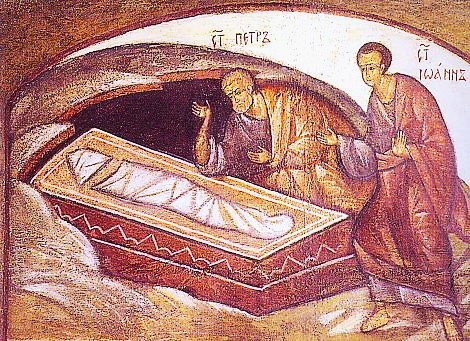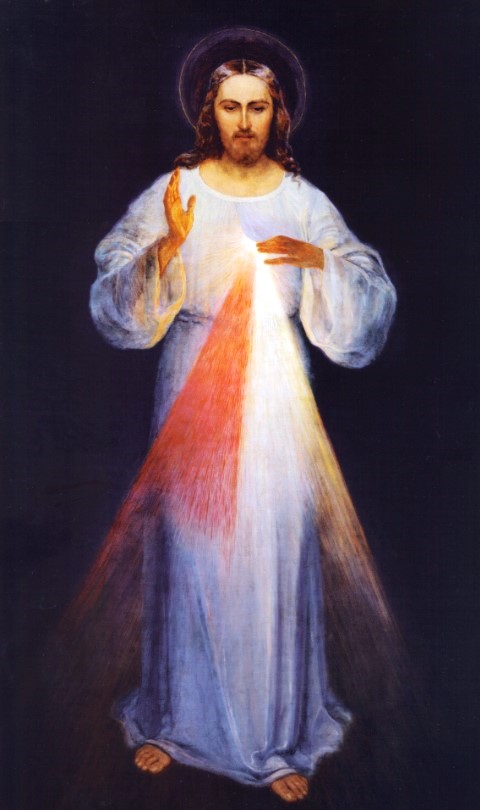Translation of the Epistle of St. Peter:
Dearly beloved, laying away all malice and all guile and dissimulations and envies and all detractions, As newborn babes, desire the rational milk without guile, that thereby you may grow unto salvation: If so be you have tasted that the Lord is sweet. Unto whom coming, as to a living stone, rejected indeed by men but chosen and made honourable by God: Be you also as living stones built up, a spiritual house, a holy priesthood, to offer up spiritual sacrifices, acceptable to God by Jesus Christ. Wherefore it is said in the scripture: Behold, I lay in Sion a chief corner stone, elect, precious. And he that shall believe in him shall not be confounded. To you therefore that believe, he is honour: but to them that believe not, the stone which the builders rejected, the same is made the head of the corner: And a stone of stumbling and a rock of scandal, to them who stumble at the word, neither do believe, whereunto also they are set. But you are a chosen generation, a kingly priesthood, a holy nation, a purchased people: that you may declare his virtues, who hath called you out of darkness into his marvelous light: Who in times past were not a people: but are now the people of God. Who had not obtained mercy: but now have obtained mercy.
Continuation of the Holy Gospel According to St. John:

Peter and John Find the Folded Burial Cloths of Christ
At that time, on the first day of the week, Mary Magdalen cometh early, when it was yet dark, unto the sepulchre; and she saw the stone taken away from the sepulchre. She ran, therefore, and cometh to Simon Peter, and to the other disciple whom Jesus loved, and saith to them: They have taken away the Lord out of the sepulchre, and we know not where they have laid him. Peter therefore went out, and that other disciple, and they came to the sepulchre. And they both ran together, and that other disciple did outrun Peter, and came first to the sepulchre. And when he stooped down, he saw the linen cloths lying; but yet he went not in. Then cometh Simon Peter, following him, and went into the sepulchre, and saw the linen cloths lying, And the napkin that had been about his head, not lying with the linen cloths, but apart, wrapped up into one place. Then that other disciple also went in, who came first to the sepulchre: and he saw, and believed. For as yet they knew not the scripture, that he must rise again from the dead.
The Saving Words of the Gospel.
In the Name of the Father, of the Son, the Holy Ghost, Amen.
Transcription of Sermon
I was delighted when John and Kaitlin picked this day for their wedding because it’s still a Solemnity. We are still in what’s called the Octave of Easter, and today is called Sabbato in Albis. Sabato in Albis means the Saturday in White because, in the early Church, those who had just been received in the Easter Vigil would wear their white baptismal robes the entire week of Easter. They would go to Mass in the morning, as a group, and then go to Vespers at night together. And so, people in the town would see this group of white-clad people as a witness of their baptism, a witness of this transformation that they underwent. And this is why, in fact, for the first 11 centuries of the Church, it was forbidden to work during the Easter Octave so that everyone can go to the morning Mass, and then the evening prayer, Vespers, and these white-clad, neophytes then were serving as a witness. And then, today would be the last day that they wore those white baptismal robes. And, at a certain point in the Mass, they would take the white robes off, and they would be handed to the bishop. And then, they were in their ordinary clothing.

Mosaic of Catechumen, Battistero di San Giovanni in Fonte
And there’s some symbolism there to the early Catholic imagery, they would show baby birds being kicked out of a nest. In other words, you’ve been baptized, you’ve lived this, you’ve done all the years of preparation for baptism, you’ve lived this week with us in an intense way, now you’re on your own. But then, they would be brought to mind what they were told at the Easter Vigil: “Receive this white garment and see that you wear it without stain to the Judgment Seat of Our Lord Jesus Christ, that you may enjoy life everlasting. Receive this burning light and safeguard your baptism by a blameless life. Keep God’s commandments so that when Our Lord comes to the Marriage Feast, you may be worthy to greet Him with all the saints in heaven, and all the saints in the heavenly court and live forever and ever.” So, they were reminded of these counsels that they heard right before their baptism.
And we also see this robe, this garment, the burial shroud of Christ that was also laid aside, in today’s reading. In pagan religions, the adherents to these pagan religions would dress up as their gods on certain feast days. But Paul tells us something else, he says, “You have, in your baptism, you have put on Christ.” And so, we don’t have some get-up that looks like an animal or anything less than the life of Christ within the soul, which is baptismal grace. And so, this baptismal grace then becomes the new garment. The white robes were a sign of it. The baptismal garment is something that is interior. And this is called the life of grace. If we should lose it, through sin, we’re invited to Confession. It’s a treasure, more valuable than life itself.
And we also heard Peter in the Epistle today, because we’re still in the Octave of Easter, we had to use the readings and the formulary from Easter Saturday, Sabato in Albis, and it’s a fitting set of readings. Those who are now conjoined to Christ, through grace, through the sacrament of baptism, then are called living stones; they build up the Temple of Christ. And Christ is called the cornerstone without which the structure does not stand. So, this being made a living stone being configured conjoined to Christ, is a fait accompli, but it’s also a process, a lifelong process of conversion. A stone had to be extracted from the quarry, it had to be chiseled, it had to suffer all sorts of transformations in order to fit into the living edifice. And so, this is a process that is not done as long as we’re in this life, of being transformed, configured to Christ, or returning to Christ and letting Him start that process again.
When I was pastor at this beautiful church, years ago, the happiest years of my life, it was wonderful, and that’s where I got to know John, and his family, and many of you. And Kaitlin I got to know several years ago. I used to have a wedding every Easter Saturday because of the significance of this, but it’s not only Easter Saturday. It is not only Sabato in Albis, this is also the Vigil of Divine Mercy.

Divine Mercy, Eugeniusz Kazimirowski, 1934
Tomorrow is the Feast of Divine Mercy when we are enjoined by Christ to confess our sins, to experience His Mercy, to let Him chisel us, to let Him, in the good sense obviously. To let Him fashion us, form us, adapt us to Him, so that we can be living stones. And it’s precisely in virtue of this baptism that we witnessed today this Sacrament of Matrimony, which is the only sacrament of the Church that is self-administered. So, the priest, you, none of us are ministers of the Sacrament of Matrimony today. John and Kaitlin are in virtue of their being members of Christ. They were baptized and it is in virtue of this baptism that they will administer the sacrament to themselves. And we are here, well, the Church is here, as witness, and also to bless this, raising it something that is natural, also called by John Paul II the primordial sacrament, something that is natural, the institution of family, raising it to something supernatural, something spiritual, a Sacrament of Matrimony, through the witness and the blessing of the Church.
This image of marriage is something that Paul refers to several times when he speaks about the relationship between Christ and the Church. Christ is the Bridegroom; the Church is His Bride. Christ lays down His life for His Bride. This is what Paul calls the great mystery. Mysterium/sacramentum it is the same word mystery, sacrament. And it’s both of those things. It is a sacrament, an outward sign of an internal grace, but it’s also a mystery, something that we cannot fully grasp. And nonetheless, we see in marriage, what we’re going to witness today, an expression, an icon, of what Christ did for us laying down His life on the Cross as the New Adam, whose side was pierced, and from His side came His new Bride, the New Eve, the Church. And the waters of baptism, when the water, the blood of His Sacred Heart was poured out, so we have what forms Christians and what nourishes Christians, baptism and the Eucharist in the Sacred Heart, as His heart was pierced in the consummation of His marriage on the Cross.
And so, that is the model for John and Kaitlin. And our Lord certainly puts the bar rather high. Christ lays down His life for His Bride. And it’s not something that just happened in one moment in history. Our Lord repeats this mystery for His Bride every day in the Eucharist when He lays down His life for His Bride in the Holy Mass, the Sacrifice of the Mass. John and Kaitlin have founded their relationship on Christ. He is the cornerstone. That’s a solid foundation. I would enjoin you to allow Christ to continue to fashion you to be fitting stones in this Temple. You are already members of the Mystical Body of Christ; He’s the Head. We can sometimes forget that in the midst of life’s difficulties, but it’s precisely in difficulties when that needs to be recalled. We lose nothing with Him. We gain everything.
Many of you come here as witnesses, but not as passive witnesses. Friends from across town, friends who live near the parish, some from Florida, some from England, who have come here to not only witness this mystery, the sacrament, but also to pray. And I invite you not only to pray for them now during Mass that they have a holy fruitful marriage and many children to bring to heaven, but to continue to pray for them after the honeymoon, when, like the birds kick out of the nest, they leave their white robes aside and are dressed just like everyone else, and have to live the heroic life of a follower of Christ. So, I invite you to not only pray for them during this Mass but to continue it afterwards.
In the Name of the Father, of the Son, the Holy Ghost, Amen.
— Fr. Ermatinger


